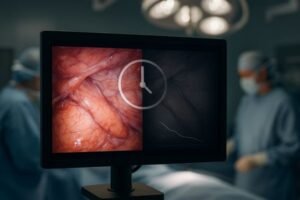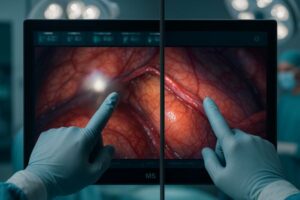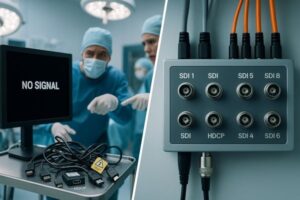During minimally invasive surgery, a standard monitor can obscure vital details due to glare or inaccurate color. A suboptimal minimally invasive surgery monitor compromises hand-eye coordination and procedural outcomes.
This 2025 guide defines the best MIS display by focusing on the core criteria surgeons need: enhanced clarity, true-to-life color for safe dissection, low-latency video for instrument control, and an OR-ready design for optimal hygiene and integration.
Top Surgical Monitors for Minimally Invasive Surgery (2025 Guide)
Recommended MIS displays combine AR glass, FHD resolution, low-latency video, and flat-front hygiene design. Here are the 2025 picks:
1⃣ Reshin MS270P — 27″ FHD, AR glass + multi-interface. This model offers excellent value for OEM integration due to its versatile I/O and robust optical performance.
2⃣ Sony LMD-2735MD — 27″ FHD, optimized for endoscopy. It is known for its strong compatibility and exceptional color accuracy, making it a reliable choice for diverse surgical environments.
3⃣ FSN FS-L2702D — 27″ FHD, multiple I/O + PIP/PBP multi-view. Its advanced multi-view capabilities make it ideal for procedures requiring simultaneous display of multiple video sources.
4⃣ Barco MDSC-2327 — 27″ FHD, OR-grade design. This display excels in hygiene and durability with a fully sealed front, combined with proven low-latency performance.
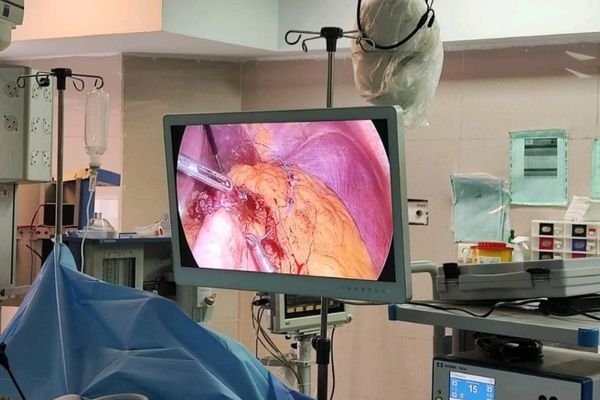
Selecting the right minimally invasive surgery monitor1 extends beyond just screen size and resolution. In MIS, the display is a critical instrument that directly influences a surgeon’s ability to operate with precision. An effective MIS display must provide an unwavering, clear view under challenging OR conditions. This guide delves into the key technologies that support this goal, from optical coatings2 that defeat glare to video processing that ensures real-time feedback. By understanding these criteria, teams can make a more informed decision.
What defines the best minimally invasive surgery monitor (MIS display) in 2025
Relying on resolution specs alone can be misleading. A monitor with a high pixel count can still perform poorly if it cannot handle the bright, reflective environment of an operating room.
The best MIS display is defined by the clinical trust it inspires. This comes from consistent contrast under OR lights, accurate tissue tone representation, and predictable, low latency that enables precise instrument control.
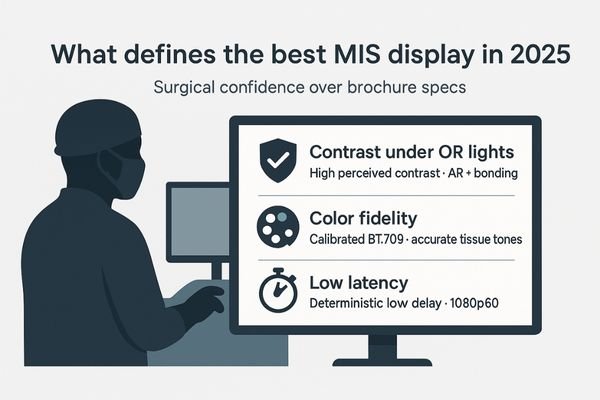
The ultimate benchmark for a minimally invasive surgery monitor3 is not on a spec sheet but in its ability to earn the surgeon’s trust. This confidence is built on a foundation of reliable and consistent visual performance4 in the real world.
An effective display must cut through veiling glare from overhead lights, which can wash out anatomical details. It must also render the subtle variations in tissue color with absolute fidelity, as these tones provide vital information about perfusion. Finally, it must display the video feed with virtually zero perceptible lag, ensuring the surgeon’s hand movements are perfectly synchronized with the on-screen image.
AR glass and optical bonding: enhancing clarity in MIS displays
The air gap between a standard monitor panel and its outer glass creates internal reflections. These reflections act like a veil, reducing image clarity and contrast under bright OR lights.
Anti-reflection (AR) glass combined with optical bonding is the definitive solution to glare in MIS displays. This technology eliminates internal reflections and parallax, ensuring a consistently clear view even from sharp, off-axis angles.
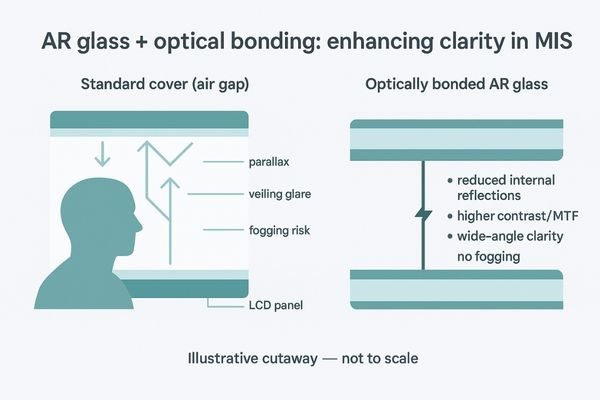
Optical bonding5 is a critical manufacturing process that directly enhances what a surgeon sees. It involves laminating the protective front glass directly onto the LCD panel, filling the air gap that would normally exist with a transparent resin. This single step removes two reflective surfaces from the optical path.
The result is a dramatic improvement in perceived contrast and a much clearer image that appears to be on the surface of the glass. This is particularly important for MIS displays6 on articulating booms, where teams view the screen from various angles. Unlike standard monitors, an optically bonded screen maintains its clarity, providing the entire team with the same high-quality visual information.
Accurate tissue color and FHD resolution for MIS displays
Inaccurate or oversaturated colors can be clinically dangerous. They might mask subtle bleeding or misrepresent the health of tissue, leading to flawed intraoperative judgments.
For most MIS procedures, a full HD (1920×1080) resolution with a professionally calibrated color pipeline is essential for safety. This ensures tissue structures, perfusion, and bleeding are represented faithfully on the MIS display.
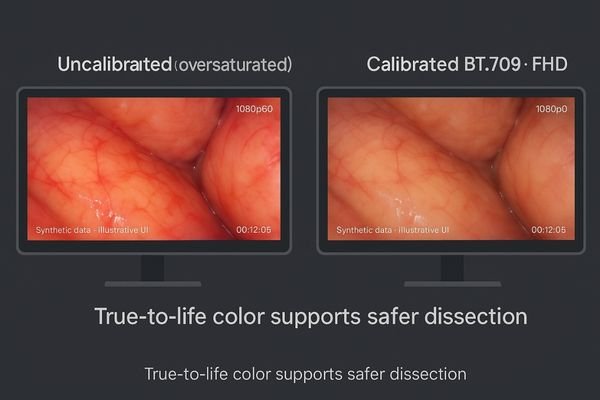
While 4K resolution has its place, a high-quality Full HD monitor7 remains a robust and effective standard for a wide range of minimally invasive procedures. The critical factor is not the sheer number of pixels, but the accuracy of the color information presented.
A dependable MIS display must have a color pipeline calibrated to medical standards8, ensuring a truthful representation of the anatomy. This includes accurate gamma curves that allow for clear differentiation of subtle tissue tones. For instance, the MS270P focuses on color fidelity within its FHD resolution, helping surgeons assess tissue viability and identify bleeders with a higher degree of safety. A well-calibrated FHD image provides the necessary detail for confident dissection.
Low latency & signal integrity in minimally invasive surgery monitors
Any delay between a surgeon’s instrument movement and the on-screen image can be disorienting. This lag, or latency, disrupts hand-eye coordination and can compromise the precision of delicate tasks.
In MIS, low and deterministic latency is more critical than any other video spec. A minimally invasive surgery monitor that processes the video signal with minimal, consistent delay keeps the surgeon’s movements perfectly synchronized.
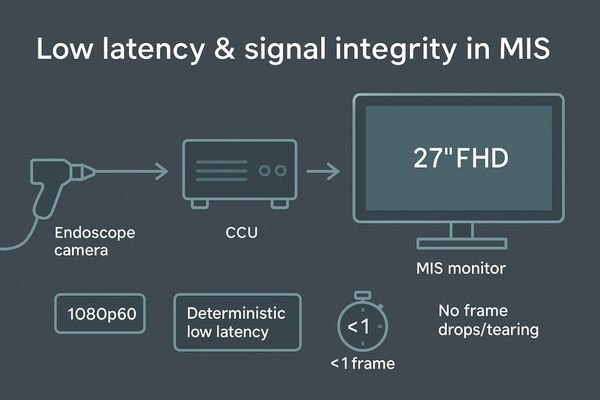
Minimally invasive surgery is a real-time discipline that hinges on flawless hand-eye coordination. The surgical monitor9 is a central component in this feedback loop, and its ability to display the camera feed with minimal delay is paramount. The ideal latency is not just low, but also "deterministic," meaning the delay is constant frame after frame.
This consistency allows the surgeon to subconsciously adapt and operate as if looking directly at the anatomy. To achieve this, a monitor must have an optimized video processing chain and support robust signal interfaces like SDI and DisplayPort, which ensure signal integrity from the source to the display.
| Signal Interface | Typical Use Case in MIS | Key Advantage |
|---|---|---|
| SDI | Direct connection from endoscopic camera processors. | Locking connector, long cable runs, uncompressed signal. |
| HDMI | Connecting to various medical devices and computers. | Ubiquitous and versatile. |
| DVI | Legacy digital video sources. | Ensures backward compatibility with older equipment. |
| DisplayPort (DP) | High-resolution computer and video sources. | High bandwidth and stable digital connection. |
Hygiene and OR integration: flat-front design and versatile I/O
Standard monitor designs with raised bezels create crevices where fluids can accumulate. This makes thorough disinfection between procedures difficult and time-consuming.
An efficient OR workflow demands a sealed, flat-front monitor design. This, combined with a versatile I/O panel, ensures rapid hygienic turnovers and seamless integration with any endoscopy system.
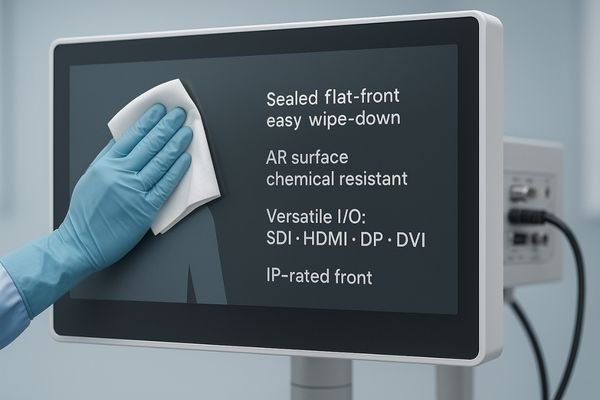
The physical design of an MIS display is a critical factor for both infection control and operational efficiency. A "true flat10" front surface, where a single sheet of protective glass extends to the edges, is the modern standard. This design eliminates hard-to-clean crevices, allowing staff to wipe the surface clean in one pass.
Beyond hygiene, seamless integration is key. A comprehensive set of input/output (I/O) ports11 is necessary to ensure compatibility with equipment from various manufacturers. Native support for SDI, DVI, HDMI, and DisplayPort prevents the need for external adapters, which can become points of failure in the OR.
| Feature | OR Benefit |
|---|---|
| Flat-Front Design | No crevices for contaminants; allows for fast and thorough wipe-downs. |
| IP-Rated Front | Sealed against liquid ingress, protecting internal electronics from splashes. |
| Versatile I/O | Native support for SDI, HDMI, DVI, and DP ensures compatibility with any system. |
| Durable Casing | Chemical-resistant housing withstands repeated cleaning with harsh disinfectants. |
Buying checklist for MIS displays
Choosing a monitor from a catalog can be overwhelming. To avoid selecting a display that looks good on paper but underperforms in the OR, a focused, function-first approach is necessary.
Use a practical checklist to guide your purchasing decision. Verify these key features to ensure the MIS display you choose will deliver confidence, safety, and efficiency in your surgical environment.
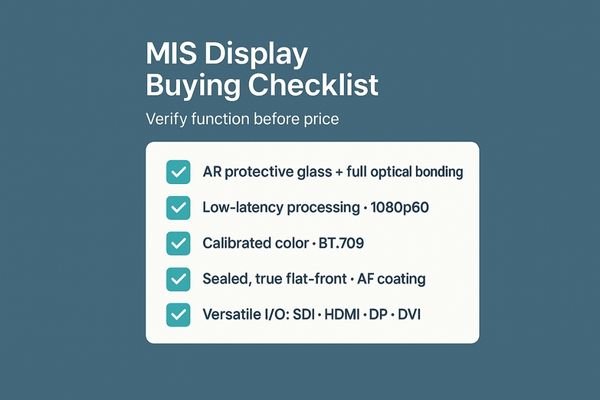
This checklist prioritizes real-world clinical performance over marketing specifications. By using it as a framework for evaluating any minimally invasive surgery monitor, you can confidently select a display that is truly fit for purpose.
- Optical Performance: Does the monitor feature AR protective glass with full optical bonding to reduce glare?
- Color Accuracy: Is it a Full HD (1920×1080) display with a calibrated, medical-grade color pipeline?
- Latency: Has it been engineered for low and deterministic latency, especially with SDI/DP inputs?
- Hygiene: Does it have a sealed, true flat-front design for easy and effective cleaning?
- Integration: Does it offer a versatile I/O panel including SDI, HDMI, DisplayPort, and DVI?
Conclusion
The best MIS display combines AR-bonded optics, accurate FHD color, low-latency video, and a hygienic, integration-ready design to provide unwavering clinical trust and enhance surgical precision. ⚡
👉 For tailored MIS display solutions and professional guidance, contact martin@reshinmonitors.com.
-
Explore this link to discover top-rated monitors that enhance surgical precision and improve outcomes. ↩
-
Learn how optical coatings can significantly reduce glare and enhance visibility in operating rooms. ↩
-
Explore this link to discover top-rated monitors that enhance surgical precision and surgeon confidence. ↩
-
Understanding visual performance can significantly improve surgical results; this link provides valuable insights. ↩
-
Explore this link to understand how optical bonding enhances visual clarity in medical displays. ↩
-
Learn about MIS displays and how they improve surgical outcomes through better visual information. ↩
-
Explore this link to understand how Full HD monitors enhance surgical precision and safety in medical settings. ↩
-
Learn about the importance of color calibration in surgical displays for accurate anatomical representation. ↩
-
Learn how advanced surgical monitors enhance precision and safety in operations, making them essential tools in modern surgery. ↩
-
Understanding true flat design can enhance infection control and operational efficiency in medical settings. ↩
-
Exploring the significance of I/O ports can help ensure compatibility and reduce equipment failure in operating rooms. ↩

